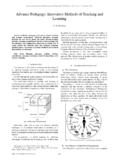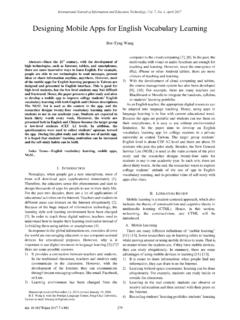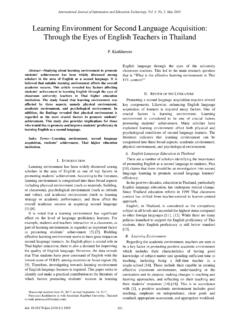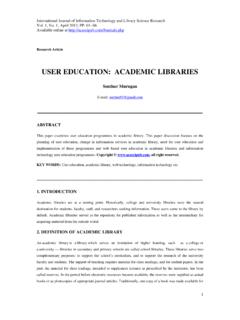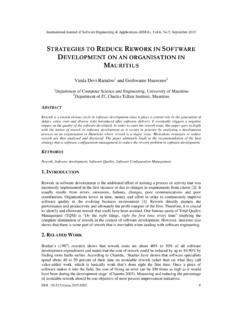Transcription of Effects of Visualization on Academic Performance of ...
1 international journal of information and Education technology , Vol. 4, No. 2, April 2014156 DOI: Abstract This study investigated the Effects of Visualization on college students Academic Performance . One control group and two experimental groups were utilized. The participants were the first year Bachelor of Science in Psychology students of Batangas State University. Results obtained from the experiment showed that Visualization has no significant effect on the Academic Performance of the two experimental groups. However, grade improvements were higher in these treatments compared to the control group. The students Performance before and after the Visualization showed a computed p-value of and respectively, higher than level of significance which failed to reject the null hypothesis.
2 On the other hand, the control group showed significant effect which yielded a p-value of lower than the level of significance. The results also showed a chi-square value of for experimental groups 1 and 2 which made the two approaches equally significant in improving Academic Performance . Index Terms Academic Performance , college student, positive psychology, Visualization . I. INTRODUCTION Visualization is a process of cognitive stimulation to direct things imagined to work. According to Jack Canfield (2005) in order to reach a goal, one has to visualize the goal as already complete in vivid detail, and then allow yourself to feel that result of your goal (fuel the emotions) [1]. Tal Ben-Shahar, an author and lecturer of Positive Psychology at Harvard University, mentioned during one of his lectures that a study by Shelley Taylor, , a psychologist at University of California, Los Angeles (UCLA), conducted an experiment on how Visualization affects individuals in achieving goals.
3 This study became the basis and framework of the researchers experimentation. Science has indeed shown that Visualization does work to some extent, primarily in the field of Sports Psychology. An experiment done by Australian psychologist Alan Richardson has revealed that athletes who visualized shooting free throws did just as well as those who actually practiced [2]. A study in Ohio by GuangYue, an exercise psychologist from Cleveland Clinic foundation, showed that by visualizing weightlifting, athletes gained muscle mass nearly as much as half the mass as those who actually trained; and prominent athletes who use Visualization in sports are Tiger Woods, Jack Nicklaus, and Muhammad Ali [3]. Manuscript received June 25, 2013; revised November 8, 2013. N. L. Narvacan and E. A. Bulaqui a are with Batangas State University, Batangas City, 4200, Philippines (e-mail: L.)
4 D. Evangelista is with the College of Arts and Sciences, Batangas State University, Batangas City, 4200, Philippines (e-mail: Thoughts generate the similar mental instructions as actions according to brain studies. Cognitive processes are affected by mental simulation. Doing mental exercises can improve one s effectiveness in Performance and motivation. It can also increase confidence and chance for success in any endeavours in life [3]. Mental exercise can be practiced as one of the ways to attainsuccess [3]. This notion of cognitive exercise aroused the researchers interest to conduct the study to help students become more optimistic in their studies. Moreover, they wanted to determine how Visualization can help improve students Performance by acquiring better study habits and positive behavior towards schooling. In this generation of modern advancement, changes greatly affect students mindset toward schooling.)
5 Some of them become very negative or unconcerned with their studies even during examinations and tend to get low grades. Lack of motivation and positive thinking is one of the factors that affect poor Performance . This investigation aimed to know the effect of Visualization in students Academic Performance . To determine a more effective method of Visualization was also the thrust of the study. II. METHODOLOGY A. Research Design This study is a true experimental design. It specifically investigated the Effects of Visualization among first year BS Psychology students Academic Performance to determine if this method can improve Performance , study habits, and positivity. The statistical treatments used were mean, standard deviation, paired t-test, independent t-test, and chi-square. B. Participants The participants in this study were the first year BS Psychology students of Batangas State University.
6 The samples were chosen using multistage sampling technique particularly stratified proportional sampling and simple random sampling. The researchers obtained the following number of participants for each treatment using the Slovin s formula. Both the control group and the experimental Group 1 had 24 out of 29 students. The experimental Group 2 had 23 out of 29 students. C. Materials Results of the Semi-final examination (Science, technology , and Society subject) Grades on the Midterm examination (Science, technology , and Society subject) Mobile phones Effects of Visualization on Academic Performance of College Students Ni o Fredrico L. Narvacan, Evangeline Atienza-Bulaqui a, and Lucille D. Evangelista international journal of information and Education technology , Vol. 4, No. 2, April 2014157 Daily Note Sheet After-experiment evaluation sheet (for personal evaluation) D.
7 Procedure The researchers informed each class about the experiment. It was assumed that the participants were willing to be part of the experiment. The participants were briefly informed about the methodology and the relevance of the study. However, the real purpose and nature of the study was not disclosed until the experiment was finished to avoid external and internal contaminations of results. The participants in each section represented each of the different treatments. Section 1201 was the control group wherein basically no treatment was provided, but they were simply asked to take down notes of their study habits. Section 1202 served as the first experimental group wherein the participants were asked to visualize the goal of achieving a grade of (98-100) and to evoke the emotion of happiness and pride upon achieving that goal on Science, technology , and Society (STS) subject for their Semi-final examination.
8 Lastly, Section 1203 stood as the second experimental group wherein the participants were told to visualize the goal of achieving a grade of (98-100) and to evoke the emotion of happiness and pride upon achieving that goal as well as the journey or actions toward the goal like studying and reviewing lectures and notes, listening to the professor during classes, taking down notes, actively participating in class discussions, going to the library to study, doing group studies, and turning down friends who invite them to go out. Each participant was to carry out the instructions for seven consecutive days each morning upon waking up for five minutes. They were reminded by the researchers every day for seven days through personal monitoring and SMS messaging. If they were not able to do so, then they were told to do it before they go to sleep.
9 The participants took the Semi-final examination on the scheduled day of the exam which was the date indicated in the university calendar. The researchers took the results of the Semi-final examination as well as the Midterm examination from the Science, technology , and Society (STS) professor for statistical evaluation. After the experiment, the participants were debriefed (that is explaining the true nature and purpose of the study). E. Research Matrix III. RESULTS TABLE I: MEAN AND STANDARD DEVIATION OF Academic Performance OF PARTICIPANTS IN STS SUBJECT Group Midterm Mean s Semi-final Mean s Control Experimental1 Experimental2 The mean shows where the data is centered. The table presents the mean scores for the Midterm examination of the control group of , the experimental Group 1 of , and the experimental Group 2 of It can be noted that the control group got the highest mean score.
10 On the other hand, the mean score for the Semi-final examination of the control group was , the experimental Group 1 was , and the experimental Group 2 was The standard deviation shows how spread the data is. The table shows that the standard deviation for the Midterm of the control group was , the experimental Group 1 was , and the experimental Group 2 was On the contrary, the standard deviation for the Semi-final of the control group was , the experimental Group 1 was , and the experimental Group 2 was Fig. 1. Distribution of scores of respondents in the Control Group. It can be noted that the result of the Midterm examination of the control group is higher compared to their Semi-final examination. Fig. 2. Distribution of scores of the respondents in the Experimental Group 1. Fig. 2 shows the variation of scores of Midterm and Semi-final of the experimental Group 1.
